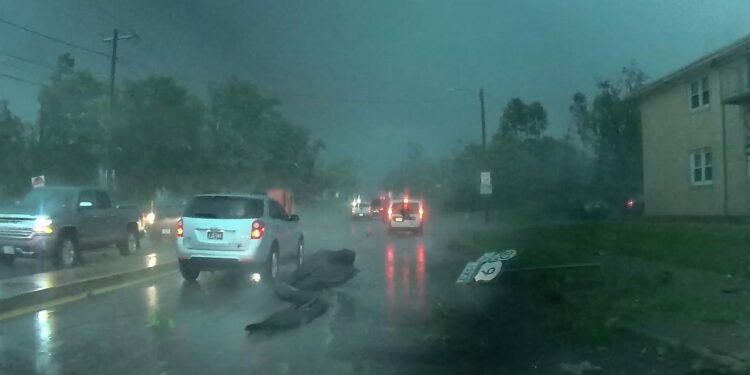Severe weather rips through Midwest US, 545K left without power
Much of the Midwest faced severe weather Monday night, with tornadoes reported in the Chicago metro area.
A line of severe thunderstorms will move east across the Midwest and into the East Coast on Tuesday after a large swath of the Midwest experienced severe weather that left at least one dead the day before.
The heavy rain left parts of the Midwest at risk of flash flooding on Tuesday.
A stretch of Missouri and Illinois were placed under a flash flood warning, hours after the National Weather Service issued a flash flood threat in southern-central Indiana into the early hours of Wednesday.
East-central Missouri was also hit with a tornado warning just after noon on Tuesday after radar detected a tornado moving at 15 mph, according to the weather service.
As of Tuesday morning, more than 340,000 customers were without power in Illinois and Indiana, according to poweroutage.us.
Severe thunderstorms could also strike the New York area on Tuesday. The agency’s Albany office warned of heavy rainfall and damaging winds that could down power lines as scattered storms spread through the evening.
The severe weather on Tuesday comes after a “complex of destructive storms” moved across eastern Iowa into northern Illinois on Monday night, according to the National Weather Service office in Chicago. Multiple tornadoes were reported along the line of storms as it moved through the Chicago metro, the agency said, adding that its staff had to briefly seek shelter from a tornado.
The weather service confirmed three tornadoes on Monday night. One tornado was confirmed by radar near Sugar Grove, a village about 46 miles west of Chicago, according to the weather service. Another two tornadoes touched down near Des Moines, Iowa – one in Windsor Heights and another in Grimes.
More: Video shows passengers sheltering in place at Chicago airports due to possible tornadoes
By late Monday, the agency said Cook County — the most populous county in Illinois and includes Chicago — was “tornado warning free” after dozens of circulations moved over Lake Michigan.
But the agency warned that damaging winds remained as the line of storms moved across northwest Indiana. “There was a lot of damage across our area,” the weather service office in Chicago said on X.
A 44-year-old woman died in Cedar Lake, an Indiana town around 45 miles south of Chicago, on Monday night after a tree fell on her home amid the severe storms, the Lake County Coroner’s Office posted on Facebook.
The line of storms was expected to “reorganize and trend severe” as they moved east into Monday night, according to AccuWeather. A hazardous weather outlook was issued on Tuesday morning for northern Indiana, southwest Michigan and northwest Ohio, with a low chance of thunderstorms and showers forecasted throughout the area.
“The storms in Milwaukee and Chicago will be closer to the evening commute, and much of Michigan and Indiana, including Detroit and Indianapolis, will have their highest risk of severe thunderstorms during the overnight hours,” according to AccuWeather Meteorologist Tyler Roys.
On Tuesday, officials in Nashville, Illinois, a town around 50 miles east of St. Louis, issued an evacuation order amid the “imminent failure” of a local dam, putting the area at risk of flash flooding.
The announcement came after a flash flood warning was issued by the National Weather Service in St. Louis through 10:45 a.m. local time. Forecasters warned that thunderstorms and heavy rain on Tuesday morning could trigger “life-threatening” flooding of creeks, streams, highways, streets, urban areas, and underpasses.
Authorities said the local Red Cross was activated and a nearby shelter was established.
More: Storm chasers follow a forming ‘multi-vortex tornado’
Monday’s series of storms was triggered by a derecho, according to Weather.com. Classified as a “wide-spread, long-lived wind storm” by the National Oceanic and Atmospheric Administration (NOAA), derechos can come with fast-moving thunderstorms and showers.
The storms are rare but can cause destruction comparable to a tornado, according to the National Weather Service. Unlike tornadoes, they generally inflict damage in one direction, on a straight-line path.
A storm must sustain winds of 58 mph or greater and leave a path of damage at least 250 miles long to be classified as a derecho, according to the weather service. Many derechos pack wind gusts that blow at more than 100 mph, toppling power lines and trees and wreaking widespread devastation.
Meteorologists only see around one derecho every one to four years. They usually strike the eastern two-thirds of the country, and 70% happen between May and August, the weather service said.
People at Chicago’s O’Hare International Airport were advised to seek shelter on Monday night amid the tornado warnings. More than 60 flights were canceled and more than 400 were delayed, according to FlightAware.
Video posted to social media showed crowds of travelers sheltering in place at O’Hare Airport and stuck inside a plane at Midway International Airport as wind and rain lashed the area.
The National Weather Service reported webcams at both airports captured “power flashes” that were likely caused by tornados or heavy wind gusts.
Meanwhile, scorching heat continued for a third week this month as more than 151 million people remained under heat alerts across the country on Monday, according to heat.gov. In Baltimore and Washington, D.C., the weather service warned of a “dangerously hot and humid” day, with temperatures expected to reach 102 degrees.
The weekslong heat wave has already set dozens of records and will challenge more records through the week, AccuWeather said.
The Weather Prediction Center said hot temperatures are expected for much of the eastern half of the U.S., with major to extreme heat risk possible.
Hurricane Beryl: Beryl produced so many tornado warnings it broke a record
The National Weather Service confirmed that at least one tornado touched down in the Urbandale area — a city part of the Des Moines metro area — on Monday evening. A round of severe weather tore through the area and a severe thunderstorm watch was in effect until 11 p.m. local time.
The Des Moines Register, part of the USA TODAY Network, reported that more than 10,000 homes in the Des Moines metro area were in the dark on Monday night.
MidAmerican Energy Company has the most significant damage in areas around Windsor Heights and Urbandale, said Geoff Greenwood, a spokesperson for the company. More than 1,400 households in Des Moines were still without power on Tuesday, while more than 14,000 were without power in the Quad Cities.
Earlier Monday, the San Juan County Sheriff’s Office in southeast Utah confirmed that a man and his daughter died late last week after they ran out of water during a hike.
The sheriff’s office said it was notified at 5:45 p.m. on July 12 of a deceased hiker in the Canyonlands National Park. About 15 minutes later, a second deceased hiker was reported in the same area.
The National Park Service reported that the pair of hikers were a father and daughter “who had become lost while hiking, according to the sheriff’s office. The air temperature at the time of the incident was over 100 degrees, the National Park Service said.
“Dispatch informed NPS of emergency 911 texts from the hikers, reporting that they were lost and out of water,” the sheriff’s office said in a statement.
The father and daughter were identified as Albino Herrera Espinoza, 52, and Beatriz Herrera, 23, both from Green Bay, Wisconsin.
On Saturday, the Santa Clara-Ivins Public Safety Department in southwest Utah said first responders were dispatched to the Snow Canyon State Park, where preliminary information showed two individuals “suffering from a heat-related incident.” The two individuals had signs of heat exhaustion and were transported to a hospital.
“While on the scene, a passerby contacted police and reported that a third individual was unconscious a short distance away,” the department said in a news release. “The individual was identified as a 30-year-old female.”
First responders determined that the woman was deceased, according to the department. Her death is being investigated by the department.
Dozens of heat-related deaths have been reported by state officials and local media this month. Although the death toll is expected to increase as the summer continues, experts previously told USA TODAY that the true death toll is likely higher.
Officials in Rockford, Illinois are investigating the death of a 76-year-old man who was trapped as flood waters swept away a pickup truck on Sunday, the Rockford Register Star, part of the USAT TODAY Network, reported.
The man was riding in the passenger seat of a Dodge Dakota truck as the woman driving tried to leave a parking lot inundated with flood water, according to the Winnebago County Coroner’s Office.
When the truck was pulled into a nearby creek, the driver escaped through a window and was rescued, officials said. The man was trapped in the truck as it sank below the water. Local law enforcement tried to pull him out, but could not rescue him.
The truck was pulled from the creek and the man was pronounced dead around three hours later.
Authorities have not named either the man who died or the woman who was rescued.
Contributing: Victoria Reyna-Rodriguez, Ryan Magalhães, and Addison Lathers, Des Moines Register
Source link : https://www.usatoday.com/story/news/nation/2024/07/16/summer-thunderstorms-tornadoes-heat-wave-united-states/74417374007/
Author :
Publish date : 2024-07-16 13:15:00
Copyright for syndicated content belongs to the linked Source.






